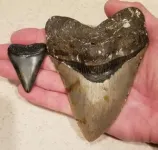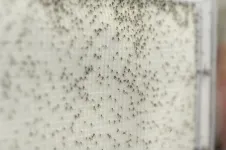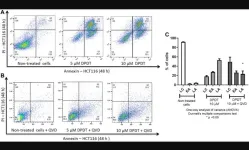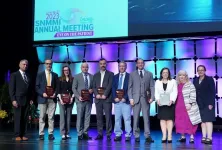(Press-News.org) University of Oklahoma assistant professor Xiaochen (Angela) Zhang, Ph.D., has received a prestigious Faculty Early Career Development Award, known as a CAREER award, from the National Science Foundation to study how relationships among non-profits, community groups and local government agencies can improve disaster resilience, resource allocation, and emergency management by enabling organizational interactions, rather than top-down responses.
Zhang, who is an assistant professor of public relations for the Gaylord College of Journalism and Mass Communication at OU, will receive $520,000 from the National Science Foundation for the five-year project that combines two existing academic theories – social network theory and transactive memory system theory – to develop a complement to standard disaster planning that aims to improve community resilience.
Working with the emergency managers for Cleveland County, Oklahoma, as well as community organizations and stakeholders, Zhang will conduct in-depth interviews, workshops and surveys to measure the communities’ social and communication networks and determine the communities’ resource needs, gaps for resources, or areas in which collaboration can be strengthened.
FEMA, the Federal Emergency Management Agency, provides emergency managers with comprehensive guides and plans for preparing for and responding to a wide range of emergency events. However, the FEMA structure emphasizes a top-down approach.
“The traditional FEMA structure is that you start with the emergency manager of the city, or the county, or the area, and then they will set up a chain of command for better management of the situation, but also for communication,” Zhang said. “That’s a really good management method, but from a communication perspective, it can obstruct the information flow, especially in disasters where each organization might have limited resources. Communicating laterally can improve the sharing of resources.”
Zhang’s project could complement the FEMA command structure by working with local organizations and intrapersonal connections at the community or neighborhood level to build a knowledge network of the resources and support systems available to a community when responding to or recovering from a disaster.
“Cleveland County is particularly well-suited for this sort of project,” said Zhang, “because of the strength of the Community Needs Network, a unique partnership of OU, the United Way of Norman, the City of Norman, and other regional non-profits.”
“A lot of emergency managers have a social network of this kind. My project is to strengthen and broaden the impact and include more community-level organizations,” she added. “Community organizations, like non-profits and community leaders, have strong social networks and resources of their own that people could use, so it’s an idea to establish communication and build the knowledge network of what each organization can do and resources they could provide during an emergency.”
On April 20, 2023, a tornado touched down in Shawnee, Oklahoma, causing two Shawnee nursing homes to transfer residents to facilities around the state overnight to maintain patient care.
“They needed transportation devices, and they were able to get that resource from school buses provided by the local school board,” Zhang said. “That’s the kind of resource connection my project could help provide. By expanding that knowledge network, more organizations will know how to access the resources they need when they need them.”
###
About the Project
The project, “Transactive Resilience: Uncovering the Effects of Social Network and Communal Capacity on Disaster Community Resilience,” is funded by an expected $520,000 grant from the National Science Foundation, Award No. 2235583. The project begins on Sept. 1, 2023 and is expected to conclude in 2028.
About the University of Oklahoma Office of the Vice President for Research and Partnerships
The University of Oklahoma is a leading research university classified by the Carnegie Foundation in the nation’s highest tier of research universities. Faculty, staff and students at OU are tackling global challenges and accelerating the delivery of practical solutions that impact society in direct and tangible ways through research and creative activities. OU researchers expand foundational knowledge while moving beyond traditional academic boundaries, collaborating across disciplines and globally with other research institutions as well as decision makers and practitioners from industry, government and civil society to create and apply solutions for a better world. Find out more at ou.edu/research
About the University of Oklahoma
Founded in 1890, the University of Oklahoma is a public research university located in Norman, Oklahoma. OU serves the state, region and nation’s educational, cultural, economic and health care needs. For more information visit www.ou.edu.
END
MINNEAPOLIS/ST. PAUL (06/26/2023) — A new study shows that current trends in environmental degradation will lead to large economic losses in the coming decades, hitting the poorest countries hardest. But there is hope: investing in nature can turn those losses into gains.
Researchers from the University of Minnesota and Purdue University published their findings in Proceedings of the National Academy of Sciences. The team developed a first-of-its-kind, global earth-economy model to capture interactions ...
William Paterson University PRESS RELEASE
EMBARGOED UNTIL MONDAY, JUNE 26, 2023, 3:00 PM EST
WAYNE, NEW JERSEY — A new study shows that the gigantic Megalodon, or megatooth shark, was warm-blooded. This latest research on the Megalodon, which lived in the world’s oceans from 23 million to 3.6 million years ago and measured about 50 feet in length, appears in the peer-reviewed journal Proceedings of the National Academy of Sciences.
The study, conceived of and led by Michael Griffiths ...
The largest marine predator that ever lived was no cold-blooded killer.
Well, a killer, yes. But a new analysis by environmental scientists from UCLA, UC Merced and William Paterson University sheds light on the warm-blooded animal’s ability to regulate its body temperature — and might help explain why it went extinct.
After analyzing isotopes in the tooth enamel of the ancient shark, which went extinct about 3.6 million years ago, the scientists concluded the megalodon could maintain a body temperature that was about ...
University of Calgary researchers have discovered how Leishmania parasites hide within the body to cause Leishmaniasis. The tiny parasites are carried by infected sand flies. Considered a tropical disease, one to two million people in more than 90 countries are infected every year. Effects range from disfiguring skin ulcers to enlarged spleen and liver and even death.
This chronic disease has been difficult to detect in the early stages. Scientists realized that the parasite was somehow manipulating immune cells but this process had not been well understood.
“This is the first study that shows how the parasite stalls the process of regular ...
CORVALLIS, Ore. – Oregon State University researchers estimate that gray whales feeding off the Oregon Coast consume up to 21 million microparticles per day, a finding informed in part by poop from the whales.
Microparticle pollution includes microplastics and other human-sourced materials, including fibers from clothing. The finding, just published in the journal Frontiers in Marine Science, is important because these particles are increasing exponentially and predicted to continue doing so in the coming decades, according to researchers Leigh Torres and Susanne Brander.
Microparticle pollution is a threat to the health of ...
Surgical and intensive care patients face a higher risk of death and longer hospital stays because they are susceptible to both hypotension and hemodynamic instability – or unstable blood flow.
These potential complications require round-the-clock monitoring of several cardiac functions by nurses and physicians, but there’s currently no singular, convenient device on the market that can measure the most vital aspects of a patient’s cardiovascular health.
Ramakrishna Mukkamala, professor of bioengineering at the University of Pittsburgh Swanson School of Engineering, and Aman Mahajan, ...
“Altogether, our results show that DPDT preferentially targets HCT116 colon cancer cells likely through DNA topoisomerase I poisoning.”
BUFFALO, NY- June 26, 2023 – A new research paper was published in Oncotarget's Volume 14 on June 21, 2023, entitled, “Diphenyl ditelluride anticancer activity and DNA topoisomerase I poisoning in human colon cancer HCT116 cells.”
Diphenyl ditelluride (DPDT) is an organotellurium (OT) compound with pharmacological properties, including antioxidant, antigenotoxic and antimutagenic activities when applied at low concentrations. However, ...
Chicago, Illinois – The Society of Nuclear Medicine and Molecular Imaging recognized ten new SNMMI Fellows today during a plenary session at the society’s 2023 Annual Meeting, held June 24-27. The SNMMI Fellowship was established in 2016 to recognize distinguished service to the society as well as exceptional achievement in the field of nuclear medicine and molecular imaging. It is among the most prestigious formal recognitions available to long-time SNMMI members.
In keeping with tradition, SNMMI’s 2022-23 president, Munir Ghesani, MD, FACNM, FACR, Mount Sinai Hospital, New York, ...
WEST LAFAYETTE, Ind. – Adranos Inc., a Purdue-originated company that grew from a doctoral project into an impactful company, has been acquired by a major Costa Mesa, California-based defense products company, Anduril Industries.
Terms of the deal were settled, and the acquisition was announced on Sunday (June 25) in The Wall Street Journal that Anduril Industries is to purchase Adranos, manufacturer of solid rocket motors and maker of ALITEC, a high-performance solid rocket fuel that gives greater payload capacity, range and speed to launch systems.
“The success of Adranos is the latest manifestation ...
A team of international scientists has used NASA’s James Webb Space Telescope to detect a new carbon compound in space for the first time. Known as methyl cation (pronounced cat-eye-on) (CH3+), the molecule is important because it aids the formation of more complex carbon-based molecules. Methyl cation was detected in a young star system, with a protoplanetary disk, known as d203-506, which is located about 1,350 light-years away in the Orion Nebula.
Carbon compounds form the foundations of all known life, ...









